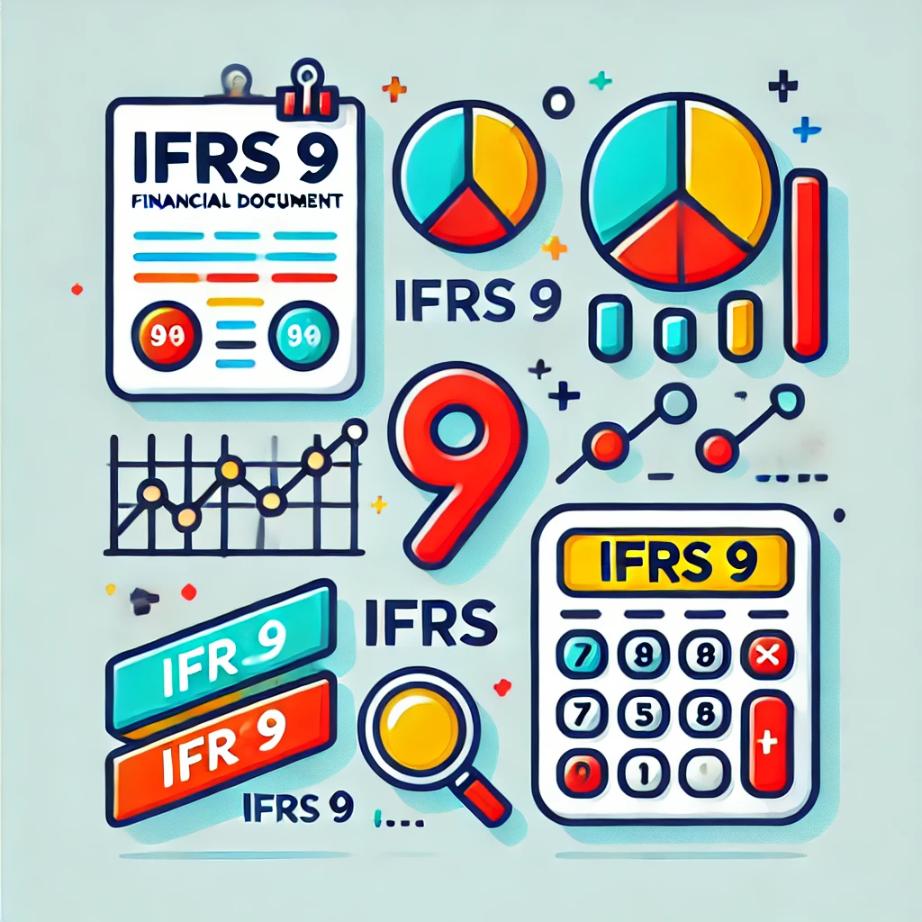金融商品会計のグローバル・スタンダードともいえるIFRS9の会話ででてくる基本的な表現やフレーズを利用した典型的な例文をとりあげまています。繰り返し練習して、IFRS9のことならすぐに会話についていけるようにしましょう!
例文
IFRS 9 introduces a new model for classification and measurement of financial assets.
- IFRS 9は、金融資産の分類と測定のための新しいモデルを導入しています。
Financial assets are classified based on the entity’s business model and the contractual cash flow characteristics.
- 金融資産は、企業のビジネスモデルと契約に基づくキャッシュフローの特性に基づいて分類されます。
Under IFRS 9, financial assets are measured at amortized cost, fair value through other comprehensive income (FVOCI), or fair value through profit or loss (FVTPL).
- IFRS 9の下では、金融資産は償却原価、公正価値で評価し「その他の包括利益」に計上する方法(FVOCI)、または公正価値で評価し損益を計上する方法(FVTPL)で測定されます。
To be measured at amortized cost, financial assets must meet the SPPI (Solely Payments of Principal and Interest) test.
- 償却原価で測定されるためには、金融資産はSPPI(元本と利息の支払いのみであること)テストに合格しなければなりません。
IFRS 9 requires entities to recognize expected credit losses (ECL) on financial assets.
- IFRS 9は、企業に金融資産の予想信用損失(ECL)を認識することを要求しています。
The ECL model applies to debt instruments measured at amortized cost and at FVOCI.
- ECLモデルは、償却原価およびFVOCIで測定される債務性商品に適用されます。
Entities must assess at each reporting date whether credit risk has increased significantly since initial recognition.
- 企業は、各報告日で初回認識以来、信用リスクが大幅に増加したかどうかを評価しなければなりません。
IFRS 9 introduces a three-stage approach for impairment of financial assets.
- IFRS 9は、金融資産の減損に対する3段階アプローチを導入しています。
In stage 1, entities recognize 12-month ECL for financial assets where credit risk has not increased significantly.
- ステージ1では、信用リスクが大幅に増加していない金融資産に対して、12か月のECLを認識します。
In stage 2, entities recognize lifetime ECL for financial assets where credit risk has increased significantly.
- ステージ2では、信用リスクが大幅に増加した金融資産に対して全期間のECLを認識します。
In stage 3, entities recognize lifetime ECL for credit-impaired financial assets.
- ステージ3では、信用が棄損している金融資産に対して全期間のECLを認識します。
Entities must provide disclosures that enable users of financial statements to understand the impact of credit risk on financial assets.
- 企業は、財務諸表の利用者が金融資産に対する信用リスクの影響を理解できるようにする開示を提供しなければなりません。
IFRS 9 requires hedge accounting to be more closely aligned with risk management activities.
- IFRS 9は、ヘッジ会計をリスク管理活動とより密接に一致させることを要求しています。
Hedge accounting under IFRS 9 aims to provide more useful information about risk management and hedging strategies.
- IFRS 9の下でのヘッジ会計は、リスク管理およびヘッジ戦略に関するより有用な情報を提供することを目的としています。
The three types of hedge relationships in IFRS 9 are fair value hedges, cash flow hedges, and hedges of a net investment in a foreign operation.
- IFRS 9の3種類のヘッジ関係は、公正価値ヘッジ、キャッシュフローヘッジ、および海外事業への純投資のヘッジです。
Entities must document the hedge relationship at inception and on an ongoing basis.
- 企業は、ヘッジ関係を、開始時および継続的に文書化しなければなりません。
IFRS 9 allows more flexibility in the use of non-derivative financial instruments as hedging instruments.
- IFRS 9は、非デリバティブ金融商品をヘッジ手段として使用することについて、より柔軟に対応しています。
Hedge effectiveness under IFRS 9 is assessed based on the economic relationship between the hedged item and the hedging instrument.
- IFRS 9の下でのヘッジの有効性は、ヘッジ対象とヘッジ手段の経済的な関係に基づいて評価されます。
Entities must discontinue hedge accounting prospectively if the hedging relationship ceases to meet the hedge accounting requirements.
- 企業は、ヘッジ関係がヘッジ会計の要件を満たさなくなった場合、ヘッジ会計を将来にわたって中止しなければなりません。
IFRS 9 requires extensive disclosures about the entity’s risk management strategy and the impact of hedge accounting on the financial statements.
- IFRS 9は、企業のリスク管理戦略およびヘッジ会計が財務諸表に与える影響に関する広範な開示を要求しています。
Entities must measure financial liabilities at amortized cost unless they are designated as at FVTPL.
- 企業は、金融負債を、それがFVTPLであると指定されていない限り、償却原価で測定しなければなりません。
For financial liabilities designated as at FVTPL, changes in fair value attributable to changes in credit risk are recognized in OCI.
- FVTPLとして指定された金融負債について、(企業自身の)信用リスクの変動に起因する公正価値の変動はOCIに認識されます。
IFRS 9 provides an option to measure a financial asset at FVTPL if doing so eliminates or significantly reduces a measurement or recognition inconsistency.
- IFRS 9は、測定または認識の不整合を排除または大幅に削減する場合、金融資産をFVTPLで測定するという選択肢を提供しています。
Entities must reclassify financial assets if the business model for managing them changes.
- 企業は、金融資産を管理するビジネスモデルが変わった場合、金融資産を再分類しなければなりません。
Reclassification of financial assets under IFRS 9 is applied prospectively from the reclassification date.
- IFRS 9の下での金融資産の再分類は、再分類日から将来にわたって適用されます。
IFRS 9 prohibits reclassification of financial liabilities.
- IFRS 9は、金融負債の再分類を禁止しています。
Entities must disclose information about the nature and effect of reclassification of financial assets.
- 企業は、金融資産の再分類の性質と影響に関する情報を開示しなければなりません。
IFRS 9 includes provisions for the derecognition of financial assets.
- IFRS 9には、金融資産の認識の停止に関する規定が含まれています。
Derecognition of financial assets occurs when the contractual rights to the cash flows expire or the asset is transferred and the transfer qualifies for derecognition.
- 金融資産の認識の停止は、契約上のキャッシュフローの権利が失効するか、資産が移転され、その移転が認識停止の条件を満たす場合に発生します。
Entities must determine whether the transfer of a financial asset qualifies for derecognition by evaluating the extent of control retained.
- 企業は、金融資産の移転が認識停止の条件を満たすかどうか、保持される支配の程度を評価することにより、判断しなければなりません。
IFRS 9 requires entities to apply the general hedge accounting model to manage interest rate risk, currency risk, and commodity price risk.
- IFRS 9は、金利リスク、通貨リスク、および商品価格リスクを管理するために一般的なヘッジ会計モデルを適用することを企業に要求しています。
Entities must measure the effectiveness of hedges on an ongoing basis to ensure compliance with IFRS 9 requirements.
- 企業は、IFRS 9の要件を遵守するために、ヘッジの有効性を継続的に測定しなければなりません。
IFRS 9 requires specific disclosures related to hedge accounting, including the type of hedges and the impact on financial statements.
- IFRS 9は、ヘッジ会計に関連する一定の開示を求めており、それはヘッジの種類や財務諸表への影響を含んでいます。
Entities should document their risk management objectives and strategies for each hedge accounting relationship.
- 企業は、各ヘッジ会計の関係性について、リスク管理目的および戦略を文書化するべきです。
Under IFRS 9, a derivative that is not part of a hedging relationship is classified and measured at FVTPL.
- IFRS 9の下では、ヘッジ関係の一部ではないデリバティブはFVTPLとして分類し測定されます。
IFRS 9 requires entities to use the expected credit loss model for financial guarantees and loan commitments.
- IFRS 9は、金融保証およびローン・コミットメントに対して、予想信用損失モデルを使用することを企業に要求しています。
Entities must provide disclosures about credit risk management practices and the impact on financial statements.
- 企業は、信用リスク管理の実践と財務諸表への影響に関する開示を提供しなければなりません。
The classification and measurement of financial assets under IFRS 9 depends on the entity’s business model for managing the assets.
- IFRS 9の下での金融資産の分類と測定方法は、資産を管理する企業のビジネスモデルにより決まります。
Entities must assess at each reporting date whether financial assets are impaired.
- 企業は、各報告日に金融資産が減損しているかどうかを評価しなければなりません。
IFRS 9 requires disclosures about the nature and extent of risks arising from financial instruments.
- IFRS 9は、金融商品から生じるリスクの性質と程度に関する開示を要求しています。
Entities must provide quantitative and qualitative information about their exposure to credit risk, liquidity risk, and market risk.
- 企業は、信用リスク、流動性リスク、および市場リスクへのエクスポージャーに関する定量的および定性的な情報を提供しなければなりません。
IFRS 9 requires entities to consider forward-looking information in the assessment of expected credit losses.
- IFRS 9は、予想信用損失の評価において、将来的な情報を考慮することを企業に要求しています。
Entities must disclose the methods and assumptions used in estimating expected credit losses.
- 企業は、予想信用損失の推定に使用される方法と仮定を開示しなければなりません。
IFRS 9 requires entities to provide reconciliations of changes in the carrying amount of financial instruments.
- IFRS 9は、金融商品の帳簿価額の変動の調整結果を提供することを企業に要求しています。
Entities must disclose the impact of changes in credit risk on the carrying amount of financial instruments.
- 企業は、金融商品の帳簿価額に対する信用リスクの変動の影響を開示しなければなりません。
IFRS 9 includes guidance on the recognition and measurement of financial liabilities.
- IFRS 9には、金融負債の認識と測定に関するガイダンスが含まれています。
Entities must apply the same criteria for the derecognition of financial liabilities as for financial assets.
- 企業は、金融負債の認識停止に対して金融資産と同じ基準を適用しなければなりません。
IFRS 9 requires entities to disclose their accounting policies for financial instruments.
- IFRS 9は、金融商品の会計方針を開示することを企業に要求しています。
Entities must provide disclosures about the fair value of financial instruments and the methods used to determine fair value.
- 企業は、金融商品の公正価値および公正価値の決定に使用される方法に関する開示を提供しなければなりません。
IFRS 9 aims to enhance transparency and comparability in financial reporting for financial instruments.
- IFRS 9は、金融商品の財務報告における透明性と比較可能性を向上させることを目的としています。


